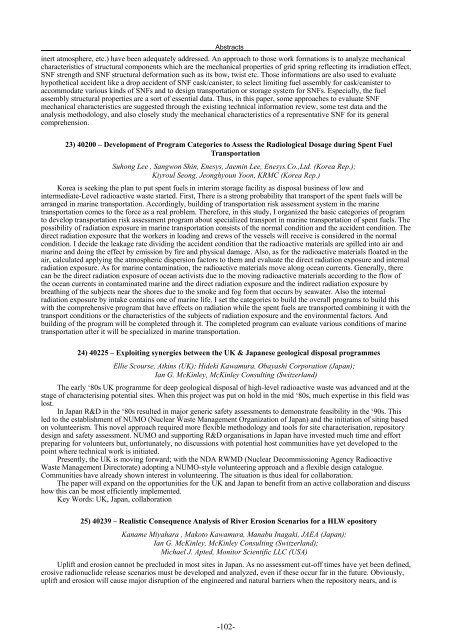ASME Message
ASME Message
ASME Message
You also want an ePaper? Increase the reach of your titles
YUMPU automatically turns print PDFs into web optimized ePapers that Google loves.
Abstracts<br />
inert atmosphere, etc.) have been adequately addressed. An approach to those work formations is to analyze mechanical<br />
characteristics of structural components which are the mechanical properties of grid spring reflecting its irradiation effect,<br />
SNF strength and SNF structural deformation such as its bow, twist etc. Those informations are also used to evaluate<br />
hypothetical accident like a drop accident of SNF cask/canister, to select limiting fuel assembly for cask/canister to<br />
accommodate various kinds of SNFs and to design transportation or storage system for SNFs. Especially, the fuel<br />
assembly structural properties are a sort of essential data. Thus, in this paper, some approaches to evaluate SNF<br />
mechanical characteristics are suggested through the existing technical information review, some test data and the<br />
analysis methodology, and also closely study the mechanical characteristics of a representative SNF for its general<br />
comprehension.<br />
23) 40200 – Development of Program Categories to Assess the Radiological Dosage during Spent Fuel<br />
Transportation<br />
Suhong Lee , Sangwon Shin, Enesys, Jaemin Lee, Enesys.Co.,Ltd. (Korea Rep.);<br />
Kiyroul Seong, Jeonghyoun Yoon, KRMC (Korea Rep.)<br />
Korea is seeking the plan to put spent fuels in interim storage facility as disposal business of low and<br />
intermediate-Level radioactive waste started. First, There is a strong probability that transport of the spent fuels will be<br />
arranged in marine transportation. Accordingly, building of transportation risk assessment system in the marine<br />
transportation comes to the force as a real problem. Therefore, in this study, I organized the basic categories of program<br />
to develop transportation risk assessment program about specialized transport in marine transportation of spent fuels. The<br />
possibility of radiation exposure in marine transportation consists of the normal condition and the accident condition. The<br />
direct radiation exposure that the workers in loading and crews of the vessels will receive is considered in the normal<br />
condition. I decide the leakage rate dividing the accident condition that the radioactive materials are spilled into air and<br />
marine and doing the effect by emission by fire and physical damage. Also, as for the radioactive materials floated in the<br />
air, calculated applying the atmospheric dispersion factors to them and evaluate the direct radiation exposure and internal<br />
radiation exposure. As for marine contamination, the radioactive materials move along ocean currents. Generally, there<br />
can be the direct radiation exposure of ocean activists due to the moving radioactive materials according to the flow of<br />
the ocean currents in contaminated marine and the direct radiation exposure and the indirect radiation exposure by<br />
breathing of the subjects near the shores due to the smoke and fog form that occurs by seawater. Also the internal<br />
radiation exposure by intake contains one of marine life. I set the categories to build the overall programs to build this<br />
with the comprehensive program that have effects on radiation while the spent fuels are transported combining it with the<br />
transport conditions or the characteristics of the subjects of radiation exposure and the environmental factors. And<br />
building of the program will be completed through it. The completed program can evaluate various conditions of marine<br />
transportation after it will be specialized in marine transportation.<br />
24) 40225 – Exploiting synergies between the UK & Japanese geological disposal programmes<br />
Ellie Scourse, Atkins (UK); Hideki Kawamura, Obayashi Corporation (Japan);<br />
Ian G. McKinley, McKinley Consulting (Switzerland)<br />
The early ‘80s UK programme for deep geological disposal of high-level radioactive waste was advanced and at the<br />
stage of characterising potential sites. When this project was put on hold in the mid ‘80s, much expertise in this field was<br />
lost.<br />
In Japan R&D in the ‘80s resulted in major generic safety assessments to demonstrate feasibility in the ‘90s. This<br />
led to the establishment of NUMO (Nuclear Waste Management Organization of Japan) and the initiation of siting based<br />
on volunteerism. This novel approach required more flexible methodology and tools for site characterisation, repository<br />
design and safety assessment. NUMO and supporting R&D organisations in Japan have invested much time and effort<br />
preparing for volunteers but, unfortunately, no discussions with potential host communities have yet developed to the<br />
point where technical work is initiated.<br />
Presently, the UK is moving forward; with the NDA RWMD (Nuclear Decommissioning Agency Radioactive<br />
Waste Management Directorate) adopting a NUMO-style volunteering approach and a flexible design catalogue.<br />
Communities have already shown interest in volunteering. The situation is thus ideal for collaboration.<br />
The paper will expand on the opportunities for the UK and Japan to benefit from an active collaboration and discuss<br />
how this can be most efficiently implemented.<br />
Key Words: UK, Japan, collaboration<br />
25) 40239 – Realistic Consequence Analysis of River Erosion Scenarios for a HLW epository<br />
Kaname Miyahara , Makoto Kawamura, Manabu Inagaki, JAEA (Japan);<br />
Ian G. McKinley, McKinley Consulting (Switzerland);<br />
Michael J. Apted, Monitor Scientific LLC (USA)<br />
Uplift and erosion cannot be precluded in most sites in Japan. As no assessment cut-off times have yet been defined,<br />
erosive radionuclide release scenarios must be developed and analyzed, even if these occur far in the future. Obviously,<br />
uplift and erosion will cause major disruption of the engineered and natural barriers when the repository nears, and is<br />
-102-


